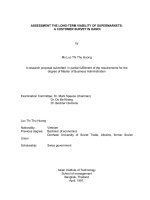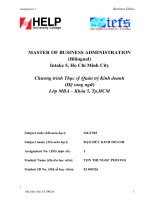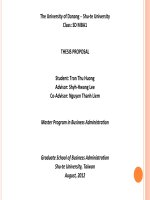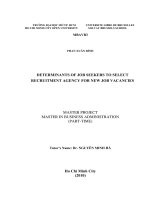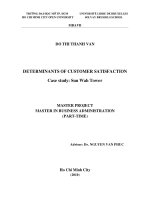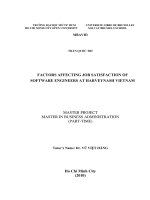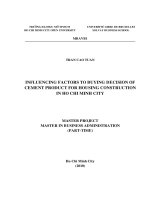MASTER PROJECT MASTER IN BUSINESS ADMINISTRATION (PART-TIME)
Bạn đang xem bản rút gọn của tài liệu. Xem và tải ngay bản đầy đủ của tài liệu tại đây (1.19 MB, 85 trang )
TRNG I HC M TP. H CHÍ MINH
HO CHI MINH CITY OPEN UNIVERSITY
UNIVERSITÉ LIBRE DE BRUXELLES
SOLVAY BRUSSELS SCHOOL
MBAVB2
Nguyen Trung Nam
Foreign Exchange Risk Management in Vietnam:
A Case Study of Petroman Ltd.
MASTER PROJECT
MASTER IN BUSINESS ADMINISTRATION
(PART-TIME)
Tutor’s Name: Dr. Nguyen Minh Kieu
Ho Chi Minh City
(2012)
Page iii of ix
DECLARATION
I hereby declare that I am the sole author of this thesis, and this thesis is the result of
my own and original work and effort and that it has not been submitted anywhere
for any award. Only the sources cited have been used in this thesis. Parts that are
direct quotes or paraphrases are identified as such.
Signature:
_____________________
Nguyen Trung Nam
Page iv of ix
ACKNOWLEDGEMENTS
First and foremost, I owe my deepest gratitude to Dr. Nguyen Minh Kieu for the
consistent instruction and guidance through the work, without which this thesis
would not have been realisable.
I also would like to take this opportunity to express my sincere thanks to my
mentor, Ms. Ho Thi Dieu Hang, for her provision of useful information and
assistance during my research.
In addition, I’m grateful to all the lecturers of the MVB2 - Solvay Business School
who have furnished knowledge and inspiration for my study and research.
I also owe thanks to my beloved wife, who keeps encouraging my study, and my
colleagues and friends, who have supported me in many different ways so that I
could finish this time-consuming work.
Page v of ix
TUTOR’S COMMENTS
Page vi of ix
TABLE OF CONTENT
ABBREVIATIONS VIII
TABLES AND FIGURES INDEX IX
CHAPTER I - INTRODUCTION 1
I. PROBLEM STATEMENT 1
II. OBJECTIVES AND RESEARCH QUESTIONS 2
III. RESEARCH METHODS 3
IV. LIMITATION AND CONTRIBUTION OF THE RESEARCH 3
CHAPTER II LITERATURE REVIEW 5
I. OVERVIEW 5
II. DEFINING EXCHANGE RATE RISKS 6
III. TYPES OF EXCHANGE RISK 7
1. Translation Exchange Risk 7
2. Transaction exchange risk 8
3. Economic/strategic exchange rate risk 9
IV. EXCHANGE RISK MEASUREMENT AND MANAGEMENT 9
1. Translation risk 9
2. Transaction risk 10
3. Economic risk 12
4. Exchange risk management organization and process in SMEs 13
CHAPTER III RESEARCH METHODS 16
I. MAIN APPROACH AND SCOPE OF RESEARCH 16
II. METHODS USED 16
1. Desk research 16
2. Quantitative Research 17
3. Qualitative Research 17
4. Other approaches 18
5. Data collection 18
CHAPTER IV FINDINGS AND ANALYSIS 19
I. COMPANY BACKGROUND 19
1. Organisation structure 19
2. Business lines and performance 19
3. Pricing structure and strategy 21
II. PETROMAN LTD EXCHANGE RISK EXPOSURE 21
1. Translation exchange risk 22
2. Transaction exchange risk 22
3. Economic exchange risk 27
4. Measurement of Petroman Ltd Risk Exposure 32
III. PETROMANS EXCHANGE RISK MANAGEMENT SYSTEM 35
1. Decision Making Process and Organisation 36
2. P E-rate Risk Management Activities 38
3. Critical Evaluation of the Existing System 44
Page vii of ix
IV. SUMMARY OF FINDINGS AND CRITICAL COMMENTS 48
1. Summary of Findings 48
2. Pitfalls of the existing ex-rate risk management system 50
CHAPTER V CONCLUSIONS & RECOMMENDATIONS 52
I. CONCLUSIONS 52
II. RECOMMENDATIONS ON TRANSACTION RISK MANAGEMENT 53
1. Improving connection amongst the functional departments/management 53
2. Credibility of the inputs and forecast 54
3. Expanding benchmarking operation 55
4. The combination of qualitative and quantitative approaches 56
III. RECOMMENDATIONS ON ECONOMIC RISKS MANAGEMENT 57
1. Reducing dependency in foreign supplies 57
2. Diversifying the clients range and business activities 58
3. Changing the operation unit establishment of a foreign-based entity 60
BIBLIOGRAPHY 1
APPENDIX 1. GUIDING QUESTIONS FOR INTERVIEW WITH PETROMAN 4
APPENDIX 2. USD/VND AND GBP/VND EX-RATES DEVELOPMENT (2007 - 2012) 7
APPENDIX 3. PETROMANS FOR-EX GAIN-LOSS (2010-2012) 9
APPENDIX 4. PETROMANS GBPVND EX-RATE EXPOSURE VALUE AT RISK (2007-2010) 12
APPENDIX 5. PETROMAN INCOME STATEMENTS (2010-2012) 14
Page viii of ix
ABBREVIATIONS
COGS
Cost of goods sale
EBT
Earning before tax
Expat
Expatriate [engineer]
Ex-rate
Exchange rate
F&A
Financial & accounting [department]
For-ex
Foreign exchange
GBP
British Pound Sterling
JPY
Japanese Yen
MNCs
Multinational corporations
NOP
Net Operating Profit
PIT
Personal income tax
SME(s)
Small and Medium Enterprise(s)
USD
United States dollar
VAS
Vietnamese Accounting Standards
VND
Vietnamese Dong
Page ix of ix
TABLES AND FIGURES INDEX
Figure 1 - Typical ex-rate risk management process 15
Figure 2 – Petroman Ltd Organisation Chart 19
Figure 3 - Petroman’s performance 20
Figure 4 - Petroman’s pricing structure 21
Figure 5 - Petroman' loans & supplier credits in USD 24
Figure 6 - Forex buying/selling activities of Petroman 25
Figure 7 – Black (parallel) market ex-rate vs. official ex-rate 2008 26
Figure 8 - Supply Chain Structure of Petroman 27
Figure 9 - Petroman’s Cashflows Diagram 28
Figure 10 - Ex-rates movement 2007-2012 30
Figure 11 - Petroman's balance of foreign currencies (2007-2012) 31
Figure 12 - Petroman's exrate gains/losses (2010-2012) 34
Figure 13 - Types of exrate gains/losses 34
Figure 14 - Relationship between the ex-rates movement and NOP (2010-2011) 35
Figure 15 - Petroman's ex-rate risk management process 38
Table 1 - Petroman’s revenue currency structure 23
Table 2 - Petroman's Swap transactions 2011 40
Table 3 - Major banks’ for-ex/derivative services 55
Page 1 of 60
CHAPTER I - INTRODUCTION
I. PROBLEM STATEMENT
In the first months of 2008, for the first time in the Vietnamese banking history
lots of commercial banks refused to buy the USD due to its depreciation against
VND, other banks only accepted to buy in the USD at the price of between VND
15,300-15,500 against the published USD/VND exchange rate of 15,865. Shortly
thereafter, USD suddenly became extremely scarce and the USD in the black
market increased by over 13 percent in May 2008 and 16 percent in August 2008,
which was said to extremely distort the profits of many Vietnamese enterprises
(Hong 2008). Thanks to selling USD at higher prices, an exporter, Gilimex,
reported in its 4
th
quarter profit after tax increase of 49.5% compared to the
previous quarter. On the contrary, enterprises having loans in USD or import
business such as SHC, Cang Doan Xa JSC, or Tan Binh Cultural JSC suffered
serious losses due to buying USD at extra costs (VNEconomy, L din nhng ―cú
sc‖ ri ro t giá (Exchange Rate Exposure Shocks shows up) 2009). The 2009
financial report of many companies listed on HOSE and HAX such as PLC, ONE,
DDM and VIP shows that exchange rates had caused exceptional income or losses
to their business results (VNEconomy, Ri Ro T giá Gây Khó Doanh Nghip
Niêm Yt (Exchange Rates Risks Causes Trouble to Listed Companies) 2010).
These are typical examples of how exchange rate movements become a major
source of uncertainty for Vietnamese companies involving international activities
such as import or export of goods and services.
The SMEs account for 90-95 percent of total enterprises in Vietnam (GSO, 2009).
In the context of further liberalisation of the economy in Vietnam, many
Vietnamese SMEs
1
have and will involve in trans-border activities in which the
for-ex rates risk (which most of them have been unfamiliar with) may become
1
In this thesis, SME is defined as enterprises which have less than 300 staff or chartered capital of less than
VND 10 billion (~USD 600,000) as per the Decree No. 90/2001/N-CP dated 23 November 2001 issued
by Vietnamese Government regarding assistance to SMEs.
Page 2 of 60
vital to their business. This problem provides the rationale for the study in this
thesis, which is to review the exchange risks management practice of these SMEs.
This thesis will identify and measure the for-ex risks and review the corporate
exchange risk management practice of a single Vietnamese SME, Petroman Ltd,
2
operating in the oil and gas manpower services industry. With its core business of
providing [expatriates] manpower agency services, it was said by the management
that Petroman Ltd’s business has been effected heavily by exchange rates
volatility during the past three years. Therefore to understand, measure and
eliminate the exchange rates risks is a critical task for the management.
II. OBJECTIVES AND RESEARCH QUESTIONS
This thesis aims to identify the exchange risk exposure associated with business
activities of a non-financial firm, Petroman Ltd and to examine the exchange risk
management process in the firm. For this purpose, the author sets out four
objectives to be achieved in the thesis:
(i) to identify the types and nature of exchange risks associated with Petroman
Ltd’s business activities;
(ii) to review and evaluate the current performance of the firm in measuring and
eliminating or limiting such risks;
(iii) to suggest a number of solutions to improve Petroman Ltd’s exchange risk
management system based on theoretical literature and actual situation and
business environment of the firm.
To obtain the above objectives, several questions of the problem will be identified
and resolved. Firstly, what types of exchange risks are affecting the business
performance of Petroman Ltd? Secondly, what have the management of Petroman
Ltd done to measure and mitigate these risks and are they successful? The last
question is how could Petroman Ltd management improve their exchange rate
2
This is a fictitious name to ensure the anonymity of the real company.
Page 3 of 60
management? By answering these questions, the thesis will help to understand the
exchange risk management process in Petroman Ltd and to recommend some
practical solution to the exchange rate problem of Petroman Ltd.
III. RESEARCH METHODS
This thesis will use two major research methods (see CHAPTER III for more
details):
Case study: the main approach of this thesis is a single case study of a business
management in real-life context, Petroman Ltd, using multi-sources of evidence.
Secondary data/desk research: the author will collect and use all the firm data and
figures made available by Petroman, public information of exchange rates and
forex policies and offers by the major banks, Vietnamese laws and regulations
regarding forex control, in order to summarise and analyse the key figures and
factors supporting the answer to the research questions.
The thesis also applied some qualitative method (interviews with different
members of the firm) and quantitative method (linear regression) to support the
case study method.
IV. LIMITATION AND CONTRIBUTION OF THE RESEARCH
Limitation: The qualitative case study approach has various advantages since it
allows insights and explanation for particular phenomena. It is suitable to the
focus of the study in the operational, economic and strategic exchange risk of a
business sector (SMEs in Vietnam) in a competitive environment, which are quite
pre-mature in terms of exchange risk management. The qualitative approach also
permits the organisational settings of the firm, the reporting process and the
management decisions on the exchange risk control. However, it is not without
certain limitations. Firstly, the reliability of the research is questionable due to
possible bias as result of the direct personal contact between the researcher and the
interviewees. Though the researcher has tried to enhance the objectiveness of the
Page 4 of 60
research by interviewing different management and staff persons, or looking at
different available data and information of the firm, the preset themes and values
of the interviewees will inevitably create reflexivity and subjectivity in data
gathering and case analysing.
Secondly, given the limited scope and resources of Petroman Ltd as an SME, a
number of financial information reported in the firm is whether incomplete,
informal or short of reliability. Moreover, the reporting procedures in the firm are
unorganised and insufficient, which make it hard to analyse the case with a high
precision. This problem itself is an obstacle for the firm to identify and measure
the extent of the problem.
Finally, the research results may lack generalisation since the case is a particular
firm in a particular business sector and operating environment, whose solutions
might not be readily applicable to other cases. This limitation, however, could be
compensated by the richness and depth of the case analysis, which could provide
better understandings and insights of the problem.
Contribution: Beside providing insights of the exchange risk management in
Petroman Ltd,
3
this research also seeks to review the current theoretical
background and practical issues of exchange risk management in Vietnam in order
to suggest the practical solutions applicable to this SME for the improvement of its
exchange risk management. By this thesis, the author hopes to contribute an
original case study to the limited collection of researches on exchange risk
management in Vietnamese SMEs.
3
Some brief information of the company is described in section I of CHAPTER IV hereunder.
Page 5 of 60
CHAPTER II LITERATURE REVIEW
In this chapter, we will review the literature of the exchange risk management,
including defining and measuring the risk, various techniques and methods for
managing the currency risks. The chapter will also summarise prior scholars’
insights, findings and recommendations for exchange risk management.
I. OVERVIEW
Since the Bretton Woods system of administering fixed for-ex rates collapsed in
1971 and a new fluctuating exchange rates system was introduced, enterprises
involving in international transactions have had more and more concerns about the
exchange rates volatility (Bartov, Bodnar and Kaul 1996). The recent booming
globalisation process has resulted in an increase in foreign currency transactions
with more uncertainty in international market.
Not surprisingly, this problem has received much attention of scholars and
practitioners in business administration. For example, many studies optimised the
questionnaire approach for analyzing exchange rate exposure management in non-
financial firms (Bodnar, Hayt, & Marston, 1998; Bodnar & Günther, 1999;
Ceuster, Durinck, Laveren, & Lodewyckx, 2000; Mallin, Ow-Yong, & Reynolds,
2001; Marshall, 2000). Others applied the interviews/case study approach with
non-quantitative nature to provide insights of the risk management practices in the
corporate sector (Belk & Glaum, 1990; Brown, 2001; Dhanani, 2003).
Another interesting approach is event study methodology, e.g. Dewenter’s study
on the exchange rate exposure of US multinational firms during Asia’s financial
crisis (Dewenter, Higgins and Simin 2005). In the absence of clear-cut theoretical
answers to the question of how corporate risk management should be organized,
these studies provide managers with information on the current practices of other
firms, which allows them to critically assess their own strategies (Glaum 2005).
Most of the literature, however, have to date concentrated in the for-ex risk
management of multinationals in Western countries, most notably in the UK
Page 6 of 60
(Dhanani, 2003; Dhanani & Groves, 2001; Belk & Glaum, 1990), the US and
Germany (Glaum, 2005; Carter, Pantzalis, & Simkins, 2004; Bodnar & Günther,
1999; Brown, 2001), Swedden (Nydahl 1999), and Romania (Balu & Armeanu,
2007; Armeanu & Balu, 2007; Armeanu, Balu, & Obreja, 2008). Some
exceptional but scarce efforts have been made in analysing exchange risk
management on global scale (Bartram 2006) or in developing countries such as
India (Sivakumar and Sarkar 2008) and Malaysia (Yazid and Muda 2006), but
very little literature targets at SMEs (Aabo, Hoeg, & Kuhn, 2009 is an exception),
and except for very limited newspaper articles and commentary notes, no research
has been seen on exchange risk management for Vietnamese SMEs.
II. DEFINING EXCHANGE RATE RISKS
According to Dhanani (Dhanani & Groves, 2001; Dhanani, 2003), the term
exchange risk
4
refers to situations in which movements in exchange rates alter the
financial performance of firms as measured by conventional financial statements
and/or corporate cashflows. Some factual examples of exchange rate risk and
exposure can be illustrated below:
In March 2008 Toyota faced very tough conditions caused by an excessive
appreciation of the JPY against the USD (Nakamoto 2008). The currency jumped
from Y105 to Y102 to the USD in just few days, while the firm said every rise of
Y1 to the USD cuts Toyota’s annual operating profits by Y35bn ($341bn). As the
car-exporter to the US market, Toyota’s major export trade is priced in USD and
the appreciation of the yen can make the yen value of the deal ―evaporate before
its eyes‖ (Nakamoto 2008). Similarly, Nitendo, a large Japanese videogame
producer, reported in October 2003 its first-ever £16 million loss as result of the
strength of the yen (Pike and Neale 2009).
4
In his definition, Dhanani did not follow the definition by Adler and Dumas (1984) who distinguished
between currency risk and currency exposure, whereby the term risk refers to the volatility of exchange
rates without any specific implications for firms, while exposure referred to the actual change in a firm’s
financial performance as a result of a movement in a rate of exchange, which definition is less used
nowadays.
Page 7 of 60
For the managment of any corporation containing exchange risks, deciding to
hedge or not to hedge is a headache issue, which depends on various factors, e.g.
their analysis/speculation of the market, their risk management approach and
strategies. In 2004, BMW announced that it would, while seeing an end to the
dollar’s two year decline, stop all the long-term hedging of the dollar (against the
euro) and gamble on a fall in the euro from its level then of $1.30 per euro. The
policies turned out to be misguided, as by 1 April 2008, the euro stood at $1.56,
creating great losses to BMW during those years.
Based on prior theoretical literature, there are three main types of exchange rate
risks: (1) translation or balance sheet risk, related to the conversion of the
positions in the balance sheet into foreign currencies; (2) transaction risk related to
commercial or international financing activity of the firm; and (3) economic or
strategic risk related to long-term movements in exchange affecting expected
future cashflows of the firm (Pike and Neale 2009). Some authors also mentioned
competitiveness risk, which is related to the relationship of the firm with foreign
competitors and could be classified as part of strategic risk (Balu and Armeanu
2007). We will now look at each type of exchange risk in details.
III. TYPES OF EXCHANGE RISK
1. Translation Exchange Risk
Translation exchange risk is the result of the restatement of financial statements of
foreign subsidiaries into parent currency terms for consolidation purpose. The
translation of the foreign currencies into the local currency, together with the
exchange rates fluctuation, may give rise to translation gains or losses in the firm’s
financial statement, in particular the balance sheet values and to a lesser extent, the
profit and loss account.
In measuring the risk and booking the gains or losses, under the Vietnamese
Accounting Standards (VAS – Standard No. 10), a foreign currency transaction
must be initially accounted by applying the exchange rate between VND and the
Page 8 of 60
foreign currency on the date of the transaction (spot exchange rate).
5
In the
balance sheet, monetary items of foreign currency origin (including liabilities)
should be reported at the closing exchange rate; but the non-monetary items of
foreign currency origin (e.g fixed assets) must be reported at the exchange rate on
the date of the transaction. Imagining that a Vietnamese firm gets loan in USD to
finance a fixed asset purchase (which is paid in USD), the above booking structure
will create a gap between the foreign currency liabilities (which will fluctuate
when represented in the balance sheet in the parent currency – VND) and the total
asset value (which is fixed in VND regardless of the ex-rates movements between
USD-VND).
6
This gap can cause great gains or losses to the firm on the balance
sheet if such ex-rate movements are volatile. To avoid the harshness of this
method the Circular 201/2009/TT-BTC issued by the Ministry of Finance on 15
October 2009
7
modified the rules that such losses (but not applicable for gains)
could be distributed to the financial costs for a maximum 5 years.
2. Transaction exchange risk
Transaction exchange risk is a most obvious and identifiable/measurable form,
which is concerned with the exchange risk involved in sending money over a
currency frontier. It exposes when the firm seek to convert their committed foreign
currency cash flows into parent currency, and the ex-rates at the date of conversion
are not certainly known. Prior literature generally encourage the management of
transaction exchange risk, because it can ―easily eliminate a company’s profit
margin‖ and ―inflict substantial losses‖ (Pike and Neale 2009). Though
movements in currency may create unexpected gains, the general view is pro a
5
However, enterprises may use an exchange rate that approximates the actual exchange rate on the date of
the transaction. E.g. the average exchange rate of a week or a month may be used for all transactions in
each kind of foreign currency arising in such week or month. If the exchange rate fluctuates greatly the
enterprises must not use the average exchange rate for the accounting work in the accounting week or
month involved (clause 9, VAS Standard No. 10).
6
In this case the net-book value of the fixed asset does not necessarily reflect its market value. Because the
fixed asset must be purchased using USD, the translation of the value at the closing date would arguably
reflect its actual value, and the losses or gains due to the ex-rate movements are not real.
7
Circular 201/2009/TT-BTC Section B, Article 6, clause 2.2(a).
Page 9 of 60
hedging strategy to fix the ex-rates for the dates that the companies have foreign
currency exposed (Dhanani 2003). There are arguments against the extremes of
leaving uncertainty to the market or speculating the market and actively hedge for
exchange profits.
3. Economic/strategic exchange rate risk
Economic exchange rate risk exposes when the value of the firm changes due to
the forex-induced changes in the projected future cashflows of the firm. Economic
exchange rate risk can be described as an extension of transaction exchange rate
risk in that it extends to cash flows in the future, not those materialised. However,
a key difference between the two types of risk is that economic exchange rate risk
look into the long term movements of the exchange rates, which may have
profound effect on the future cash flows of the firm by influencing the level of
sales, prices and input costs. In other words, this type of risk deals with the
movements in real rates of exchange (taking into account general level of
inflation). (Dhanani 2003).
IV. EXCHANGE RISK MEASUREMENT AND MANAGEMENT
1. Translation risk
The question whether this risk is a real loss has been much debated during the last
30 years. A large number of scholars and practitioners have been of the opinion
that translation risk should not be hedged or even managed, for it is concerned
with the external reporting of pass events and has no impact on the economic
value of the firm or meaningful implications for the future cashflows and market
values of firms (Dufey, 1972; Srinivasulu, 1983). As Dhanani correctly put it, the
use of derivatives to create balance sheet certainty simply transfers volatility from
the balance sheet to the firm’s cashflow since the loss/gain has no cash base
(Dhanani 2003).
However, this risk may become a problem if there are plans to realise assets held
Page 10 of 60
overseas, or if the parent firm wishes to repatriate earnings when they cannot be
profitably reinvested in the location where they arise. Moreover, the changes in the
values of reported assets and liability values may have impact on analysing key
performance measures and ratios of the firm (e.g. EPS) via overseas earnings,
gearing, etc (Pike and Neale 2009). This impact has important implications in two
aspects: (1) the exchange rates movements may adversely amend the firms’
gearing ratios quoted in parent currency, and thus will create concerns to those
firms using gearing ratios for funding arrangements; (2) the translation profit and
loss exchange risk, which however is not materialised, can reduce the actual profit
reported in parent currency compared to the expected profit reported previously.
Not surprisingly, a case study research by Brown of an American manufacturer,
HDG plc, witnessed that the firm’s senior managers wanted to manage translation
exchange risk, as they believed that the volatility in ―reported accounting
numbers‖ as a result of exchange rates movements would have adverse effect on
share price. In another study on sixteen UK companies, Belk and Glaunm found
that 81% considered managing translation exposure as important (Belk and Glaum
1990).
2. Transaction risk
Transaction risk can be easily calculated from the realised cashflows of the firm
which are also shown on the financial statements of the firm. Transaction exposure
can be hedged (neuturalised) easily by setting up counterbalancing positions using
hedging tools. For example an importing firm having a future payable cash
outflow in USD (for paying foreign suppliers) may purchase the USD today (or
using a forward contract) to fix the purchase price in VND as of the date it need
USD and avoid fluctuation of the USD/VND exchange rate. The management of
transaction risk has been the centerpiece of most firms’ exchange risk
management system (Glaum 2005). The following financial hedging
tools/instruments are the most commonly used (Sivakumar and Sarkar 2008):
Page 11 of 60
a. Forwards: a made-to-measure agreement between the firm and another party
to buy/sell a specific amount of a currency at a specific rate on a particular date
in the future. The main feature of this tool is that it can be tailored to the
specific hedgin needs of the firm but the contract is binding and not marketable
or assigned to another party if the firm want to drop in the middle.
b. Futures: a future contract is similar to the forward except that it is done
through an organised exchange market. Therefore it can eliminate the problem
of double coincidence. Futures only require a small initial outlay but a
significant amount of money can be gained or lost. However, the talorability of
future contracts is limited becaused they are highly standardised.
c. Options: a currency option gives the right, but not the obligation to buy (call
option) or sell (put option) a specific quantity of one foreign currency in
exchange for another at a fixed price (Exercise/Strike Price). Options are
usually used for contigent cash flows, e.g. in bidding processes.
d. Swaps: a swap is a foreign currency contract whereby the buyer and seller
exchange equal initial principal amounts of two different currencies at spot
rate. At maturity, the principal amount is effectively re-swapped at a
predetermined exchange rate so that the parties end up with their original
currencies, in addition the parties will exchange fixed or floating rate interest
payments in their respective swapped currencies during the contract period.
Swap allows firm to hedge apart or in full of its exchange risk without
changing its underlying borrowing position.
e. Increase/decrese borrowing level in foreign currency: borrowing in foreign
currencies can be used to hedge for-ex exposure by taking advantage of the
International Fischer Effect relationship. If an export firm is going to receive
some amount in USD in the next few months and there’s a risk that the USD
will depreciate against local currency, it can get a loan in USD and convert the
same into local currency at current ex-rate and the interest gains of local
Page 12 of 60
currency will cover the costs for interest of the loan in USD while the firm is
protected against ex-rate fluctuation. This is a very commonly used tools as per
literature (Keloharju 2001).
f. Other internal extra-contractual techniques: this includes the management
of the risk at the firm level using extra-contractual techniques such as chosing
the contract currency; re-pricing the contract adding the ex-rate risk elements;
synchronisation of encashment and payment in the same currency; lead/lag
receivables/payables; seeking credit terms from suppliers; altering credit terms
to customers; payment date game, etc (Balu and Armeanu 2007).
3. Economic risk
The measurement of economic exchange risk exposure remains incomplete to date
because the true nature of economic exposure and its impact on the value of the
firm remains largely a mystery to financial executives and thus was traditionally
ignored (Khoury and Chan 1988, 137). However, more and more scholars and
practitioners believed that economic exchange risk should be the most appropriate
basis for corporate exchange risk management (Belk and Glaum 1990) and a
multitude of factors, including international locations of a firm’s plants,
competitors, key buyers and suppliers are usually considered when assessing
economic exchange risk.
Economic exchange risk is difficult to measure and manage, and it is well
established by previous literature that conventional financial hedging tools help
little to protect firms from such future/long term risk (Dhanani 2003, 40). Two
theoretical approaches (qualitative and quantitative) have been developed by the
economists to deal with this problem. The qualitative approach considers
economic risk a kind of business risk,since it affects the strategic/competitive
profile of the firms (Dhanani and Groves 2001). The approach, therefore, focus on
the operational adjustments to alter the currency mix of the firm’s revenue/costs
structure to eliminate/manage the effects in movements of the ex-rates.
Page 13 of 60
The operational strategies are not limited within the financial executives but are
rather considered a task for the management, which may include the following
(Dhanani 2003, 41) (Dhanani and Groves 2001, 280):
a. Contract strategies: Using contractual clauses calling for assumption of
exchange risk by the customers.
b. Sourcing adjustment: Changing the sources of supply by changing suppliers
from different countries, establishing new production sites or relocating the
production sites, etc.
c. Marketing and pricing strategies: Changing the client portforlio or market of
sales to target new less competitive markets having favourable rates; adjusting
prices in response to movement in ex-rates.
On the other hand, quantitative approach seeks to measure economic risk with
statistical regression techniques and make use of financial hedging instruments to
manage such risk (Adler and Dumas 1984). Quantitative approach calculates
economic exchange risk by assessing the firm value’s sensitivity to ex-rate
movements, using partial derivative function where the dependent variable is the
firm’s value and the independent variable is the exchange rate (Aabo, Hoeg and
Kuhn 2009). Then the basis of risk management strategy will be to use financial
instruments (see section IV.2 of this Chapter) to generate sufficient gains at
maturity to offset the predicted reduction in the firm’s cash levels.
Ealier imperical studies indicated that companies either did little to manage
economic risks or applied strategies which deviated greatly from theoritical
literature (Belk and Glaum 1990). However, recent researches showed that
companies tend to take elements of both qualitative and quantitative theoretical
frameworks in their exchange risk management (Dhanani 2003) (Brown 2001).
4. Exchange risk management organization and process in SMEs
Many empirical researches have dealt with the organisation of the exchange risk
Page 14 of 60
management in MNCs (Belk and Glaum 1990) (Glaum 2005) and most of them
shown that the risk management of MNCs is highly centralised, including the
notable finding by Yazid and Muda on Malaysian MNCs (Yazid and Muda 2006).
Though there has been no literature on the organisation of exchange risk
management in SMEs, it can be assumed that SMEs generally apply a centralised
exchange management system, given their limited resources and expertise.
Economists and consultants have summarised the basic process of exchange risk
management of a firm as follows (Sivakumar and Sarkar 2008):
a. Forecasts: to develop a forecast on the market trends and the future direction
on the for-ex rates.
b. Risk estimation: based on the forcast, the value at risk (the actual profit/loss
for a move in rates based on the forecast) will be meatured and the propability
for the risk should be ascertained, taking into account market-specific
problems (such as market disruption or foreign currency policy changes) and
system risk due to inadequacies (such as reporting gaps).
c. Benchmarking: based on the risk estimates, the firm will set its limits for
handling for-ex exposure, including the decision whether to manage its
exposures on the basis of cost-center (i.e. to ensure that cash flows are not
adversely affected beyond a point) or profit center (i.e. to generate possible
profit on its exposure).
d. Hedging: based on the limits set above, the firm will then decide an
appropriate hedging strategy with the selection of one or combination of a
number of hedging tools.
e. Stop loss: the decisions made by the firm are based on forecasts which some
time turn out to be wrong. The firm will need to establish a monitoring system
to detect critical levels in the for-ex rates at which point appropriate measure
must be taken to rescue the firm.
Page 15 of 60
f. Reporting and Review: all risk management activities must be subject to
periodic reports and reviews. The reports will reflect the performance of the
risk management activities and the reviews analyses whether the forecasts of
market trend are relatively correct, the benchmarks set are effective in
controlling the exposure, and whether the overall strategy needs
change/adjustment.
Some researchers develop this process in a more detailed synthetical decision-
making process as per the Diagram below:
Figure 1 - Typical ex-rate risk management process
Source: Balu and Armeanu 2007.
The above theoretical frameworks shall be considered together with the analysis of
this thesis using the methods described in CHAPTER III below.
Page 16 of 60
CHAPTER III RESEARCH METHODS
I. MAIN APPROACH AND SCOPE OF RESEARCH
The main approach of this research is a single case study of a business
management matter in a real-life context. Petroman Ltd was selected as an
appropriate case based on the fact that (1) Petroman Ltd is a typical case of local
SMEs which encountered extensive exchange risk exposure; and (2) the author
had access to the executive management of the firm. The scope of research is the
empirical investigation of the ex-rate management progress within Petroman
during the period between 2007-2012.
II. METHODS USED
With the major approach of case study method, this research is based on a mix of
multiple sources of quantitative and qualitative evidence:
1. Desk research
The following information have been sought, collected and developed via desk
research:
Profits and Loss Report of Petroman Ltd during 2007 –2012 period;
8
Financial costs of Petroman Ltd, including currency purchase costs during
2007-2010 period on yearly basis;
Summary of for-ex gain-loss during 2010-2011 period on monthly basis;
Summary of commercial contracts and transactions made by the firm using
forexs during 2007-2010;
Summary of loans in foreign currencies which Petroman has made during
2007-2011;
Exchange rates of USD and GBP against VND published by Vietcombank
8
It should be noted that the profit and loss figures of Petroman during 2007-2009 period are only available
on yearly basis. Since 2010 the firm’s reporting procedures have been improved significantly and the
author has got access to the profit and loss reports on monthly basis.
Page 17 of 60
during 2007-2011 period (data retrieved on the 1
st
of each month);
9
Some major banks’ exchange policies, offers and practice of selling/buying
forexs and derivative products in Vietnam market;
Vietnamese laws, regulations and guidance letters regarding exchange
management and control.
2. Quantitative Research
In order to evaluate the impact of the exrate gains/losses on the business
performance of the firm, the author has developed a simple linear trendline to
evaluate the relationship between Petroman’s Net Operating Profit (NOP)
10
and
the ex-rate movements from two periods (January 2010 – March 2011 and April
2011 – April 2012), using the monthly statistics of NOP and net ex-rate gain/loss
during the period. In order to exclude any biases related to the fluctuation of the
firm’s management costs, the author has neutralised the monthly management
costs in prorate to the monthly revenue. The division into two periods is to
increase the result’s significance because Petroman’s foreign currency structure
had a significant change in April 2011 which turned Petroman from a net USD
receiver to a net USD payer. Given the fact that the 2007-2009 statistics are not
made available, the above analysis is deemed sufficient as of the measurement of
the for-ex risk exposure.
With regard to economic exchange risk, the author proposes qualitative approach
(see the next section) and the quantitative analysis of economic ex-rate risk is not
within the scope of this paper.
3. Qualitative Research
The author has undertaken personal interviews with the finance & accounting
manager, the managing director to describe:
9
This is important date to examine Petroman’s exchange risk exposure because the 1
st
day is the time of
issuing monthly invoice and also the payment date from clients for previous monthly service fee.
10
The use of NOP will avoid biases due to the exceptional financial costs and revenues (which are included
in the EBT or profit after tax.
